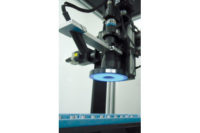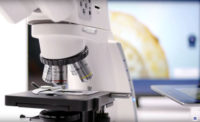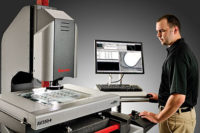Analysis of medical device materials takes place during all stages of their design and use, from initial fabrication and prototype development to examination of the device or surrounding tissues after it has been removed from the patient. Understanding materials’ properties and related performance is critical, as it can prevent device failure, improve patient safety, and drive innovations in materials and device design.
When developing metal alloys for use in medical devices, microstructural characteristics such as crystalline phase, presence of secondary phases, and uniformity of elemental distribution are assessed and combined with results from performance testing to determine whether an alloy is suitable for the intended application.
Electron microscopes are often used to analyze medical device materials. Scanning electron microscopy (SEM) with energy dispersive X-ray spectrometry (EDS) can be used for imaging and elemental analysis of bulk samples. The transmission electron microscope (TEM) provides similar information but at higher resolution, as the electron beam is transmitted through a very thin specimen. Using electron diffraction, crystallographic information can also be obtained in the TEM. TEM results complement those provided by SEM and by bulk X-ray diffraction (XRD) methods such as powder or small particle XRD.
Laboratories specializing in materials analysis employ an experienced scientific staff to analyze samples.
How It’s Done in the Field: Medical Device Analysis
A client recently approached McCrone Associates for a pre-clinical analysis of a prototype stainless steel alloy intended for use in a vascular stent. The prototype consisted of 316L stainless steel modified by addition of platinum to increase radiographic density so that the stent could be more easily visualized and monitored during and after implantation. Analysis was needed to determine the potential impact of the modification on both the elemental and structural properties of the prototype alloy.
McCrone Associates used the JEOL JEM-3010 TEM, which has an upper magnification of 1.2 million times, and can resolve features as small as 0.14 nanometer. An attached EDS system provides elemental identification of features or areas within the sample as small as three nanometers. Images, elemental spectra and electron diffraction patterns were acquired and analyzed to address questions posed by the client.
During TEM analysis, a beam of high-energy electrons is transmitted through the sample material. An ideal specimen is flat and less than 100 nanometers thick, and specialized techniques are required to produce suitable thin sections. TEM sample preparation requires understanding the sample material, the properties to be analyzed, and artifacts that may be introduced by different preparation methods. Use of the wrong preparation technique may result in non-representative or erroneous analytical results.
The Electron Microscopy Service of the Research Resources Center at the University of Illinois at Chicago thin-sectioned the samples, which included a small piece of the prototype alloy removed from a polished metallographic mount, and pieces of both 316L tubing and prototype tubing, with diameters smaller than one tenth of an inch. Two standard TEM sample preparation techniques—specifically, ion milling and electropolishing—produced the thin sections.
In the study performed on the section from the metallographic mount, McCrone Associates sought to identify the crystalline phase and elemental composition of precipitates previously observed in a light microscope examination of the mount. Precipitates are discrete particles that form within the alloy and have an elemental composition that differs from that of the matrix. Presence of precipitates is not uncommon in austenitic stainless steel alloys, where a chromium oxide coating forms on the metal and inhibits corrosion. Chromium in solution in the steel may migrate to the grain boundaries (interface regions between grains comprising a polycrystalline material; for example, a metal). The chromium can form precipitates of chromium carbide in the case of a high carbon steel, or chromium oxide in a low carbon steel, such as 316L. The introduction of platinum to the prototype alloy made it necessary to determine the composition of the observed precipitates.
Elemental analysis using EDS showed the precipitates to contain only chromium and oxygen. Measurements of atomic plane spacings obtained from electron diffraction patterns were compared to spacings for known materials, using the crystallographic database maintained by the International Centre for Diffraction Data. McCrone Associates identified the precipitates as probable Cr2O3.
The second study compared samples of 316L tubing and the platinum-modified 316L prototype tubing, to determine whether the platinum was uniformly distributed, or whether its addition led to formation of secondary phases that might compromise the physical properties of the modified alloy. TEM imaging showed no evidence of formation of inclusions or precipitates in the modified prototype.
TEM EDS analysis showed uniform elemental distributions throughout the 316L and platinum-modified alloys. There was no indication that secondary phases had formed in the prototype, or that platinum had segregated into the thin boundary regions between the grains comprising the modified alloy. Such grain boundary segregation can be detrimental to alloy strength, and it was critical to determine that this had not occurred.
Benefit from Industry Expertise in the Classroom
Learning to use specialized equipment such as research-grade microscopes can be challenging. Hooke College of Applied Sciences offers a course in transmission electron microscopes that provides practical, hands-on learning for new and experienced operators. The course teaches students the skills needed to align a transmission electron microscope, as well as how to select parameters for acquisition of images, energy dispersive X-ray spectra, and electron diffraction patterns. Students with prior transmission electron microscope experience learn how to better utilize the multiple capabilities of the instrument for materials characterization.
The transmission electron microscope is a powerful tool, uniquely suited to deliver information about feature size and morphology, crystallinity and elemental composition, on scales ranging from submicrometer to near-atomic. The capabilities of the transmission electron microscope are applicable to a wide variety of materials, including polymers, metals, minerals, pharmaceuticals and ceramics. Transmission electron microscope analysis can provide valuable insights into the relationship between microstructure and performance, speeding advances in development and improvement of products such as medical devices.




